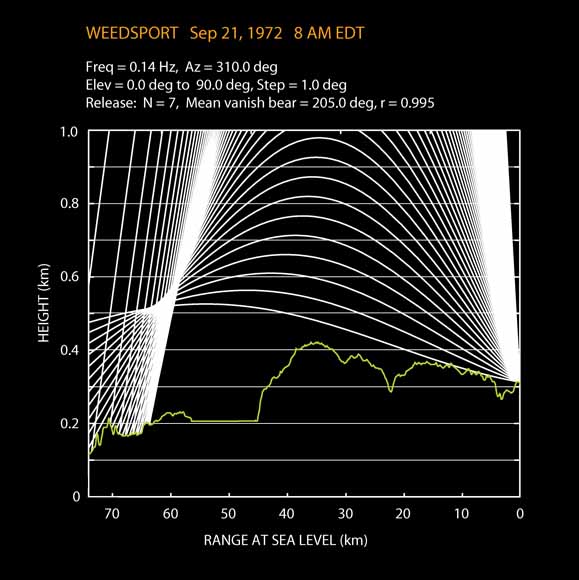
Location: Stanford University
see Map showing Mitchell and GeoCorner Room 320
This will be the 397th meeting since 1954

Transmission of infrasound (0.14 Hz) from the Cornell University pigeon loft near Ithaca, NY, north to the site of a successful release at Weedsport, NY, on September 21, 1972.

Jon Hagstrum was graduated with a BA in Geology in 1976 from Cornell University, an MS in Geology in 1979 from the University of Michigan, and a Ph.D. in 1985 from Stanford University. Since 1979 he has worked as a research geophysicist with the USGS at Flagstaff, Ariz., Denver, Colo., and, beginning in 1981, Menlo Park, Calif. His body of work lies primarily within the fields of paleomagnetism, rock magnetism, geomagnetism and plate tectonics.
Reservations: The preferred way to make reservations is simply to email John Spritzer at jspritzer@usgs.gov by May 9, tell him you will attend, commit to pay, and bring your payment to the meeting. John always emails a confirmation; if you don’t get one, assume email crashed yet again and email him a second time. A check made to “PGS” is preferred, payable at the meeting.
If you want to pay in advance:
Everyone (including Stanford folks now) Please make dinner reservations by May 9. Contact John Spritzer, at U.S. Geological Survey, 345 Middlefield Road, MS-973 Menlo Park, CA 94025, Tel.: (650) 329-4833. Send check made out to “PGS” to John.
Dinner is $30.00. Includes wine (5:30 to 6:15 PM.) and dinner (6:15-7:30 PM.).
For students from all universities and colleges, the dinner, including the social 3/4-hour, is $5.00 and is partially subsidized thanks to the School of Earth Sciences, Stanford University (Note, no-show reservations owe the full price).
Doris, whose wonderful crew prepares our meals, asked that we let you know that people who are late RSVPing and people who show up without a reservation will be welcome but that they will be eating on paper plates with plastic utensils (food supply permitting).
Dues for Academic Year 2007-2008 ($10.00) should be sent to John Spritzer, U.S. Geological Survey, 345 Middlefield Road, MS-973 _Menlo Park, CA 94025. John’s phone: (650) 329-4833.
Officers: Tom Moore, President; Keith Howard, Vice President; Mike Diggles, Secretary; John Spritzer, Treasurer; Elizabeth Miller, PGS Stanford University Coordinator

Date created: April 29, 2008
Last modified: April 30, 2008
Created by: Mike Diggles, Webmaster-Secretary, PGS.